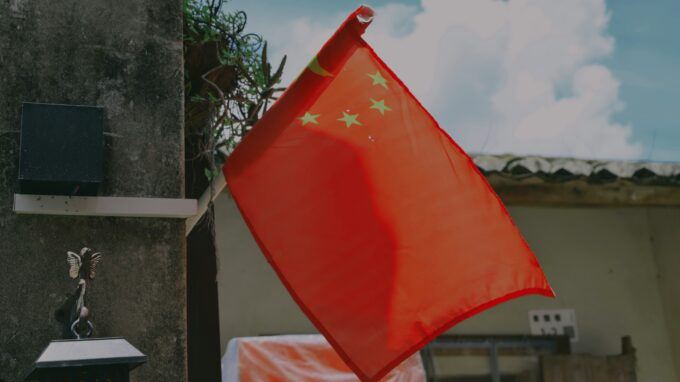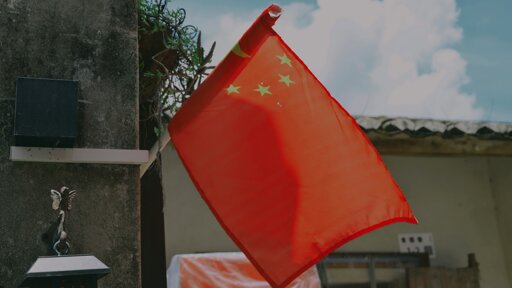
Image by Wang Binghua.
Everywhere you look, the United States is at war– at home, through military occupation of cities, institutional violence, and state-sanctioned kidnappings, and abroad, through economic coercion, proxy warfare, and endless intervention. In times like these, when it is far too easy to be overwhelmed by the inexhaustible nature of the war machine, we must remember that these are not separate crises, but different fronts of the same struggle. And to resist one is to resist them all.
The enemy, in every case, is U.S. imperialism.
Resistance movements against U.S. imperialism have sprouted up all over the world in response to its indiscriminate violence and disregard for human life. Together, they form the living front of the international left, a network of people and organizations that seek liberation from the same systems of domination and colonial control. While their forms differ, from student encampments to workers’ strikes, the purpose remains the same: an end to empire and the creation of a new multipolar world rooted in the simple truth of our shared humanity and the equal worth of every nation and people.
The alliance between China and Venezuela is part of this broader project. And the U.S. push for war against both nations is but a violent reaction to the impending truth that U.S. hegemonic status is slipping, and with it, its control on global resources, political power, and the ability to dictate the terms of development and sovereignty for the rest of the world.
Over the past month, the Trump administration has unleashed a series of strikes on Venezuelan fishing vessels, claiming they are cracking down on drug smugglers. The lie is as unoriginal as it is absurd, and a stark example of the waning facade of the supposed “morality” of liberal internationalism. Truth is often exposed during these periods of turbulence, when agitation overrides calculation; the knowledge of its imminent demise is so dire that the empire is barely trying to hide its true intentions anymore.
What is the truth, then? The truth is that the U.S. war on Venezuela has nothing to do with drugs and everything to do with control. For years, Venezuela has faced relentless pressure, economic warfare, sanctions, and constant threats designed to undermine its sovereignty and keep it under the boot of U.S. empire. As with most nations, U.S. interest in Venezuela is about strategic resources and power. First, Venezuela sits atop the largest proven oil reserves in the world, along with significant deposits of gold, coltan, and other minerals critical to technology and energy production. Control over these strategic resources means control over global markets and energy security. Second, Venezuela’s geographic location within Latin America makes it a pivotal point of leverage within the region.
Yet Venezuela’s defiance did not emerge in a vacuum. It followed more than a century of U.S. domination across the hemisphere, from the invasion of Haiti and the occupation of Nicaragua to the coups in Guatemala, Chile, and Honduras. What unites these histories is a single message from Washington: no Latin American nation has the right to chart an independent course.
The Bolivarian Revolution, launched with Hugo Chávez’s election in 1998, was a direct challenge to that order. Emerging from the ruins of neoliberal collapse, it confronted Venezuela’s historical condition as a rentier state subordinated to US interests. Chávez redirected oil revenues to social programs, such as mass education and healthcare, while expanding access to political participation through communal councils and cooperatives.
Venezuela’s defiance took continental form 20 years ago, in November 2005, when Latin American leaders gathered in Mar de la Plata, Argentina, for the Summit of the Americas. There, Washington sought to impose the Free Trade Area of the Americas (ALCA) – a hemispheric agreement that would have locked the region into permanent subordination to U.S capital.
The summit instead became a turning point in modern Latin American history. Before tens of thousands of people chanting “ALCA, ALCA, al carajo!” the governments of Venezuela, Brazil, Argentina, and others rejected the deal. That rejection, led politically by Hugo Chávez and supported by social movements across the continent, signaled the collapse of the neoliberal consensus and the rebirth of Latin American sovereignty. Out of that victory came ALBA and Petrocaribe, mechanisms of regional cooperation that prioritized social development over corporate profit. The U.S has spent decades trying to reverse it through sanctions, coups, and now, open militarization in the Caribbean.
Today, matters are complicated by the introduction of a new, increasingly powerful actor. China has, over the past few decades, maintained a strong alliance with Venezuela. Starting in the early 2000s, China began providing Venezuela with tens of billions of dollars in loans to be repaid in oil shipments. This has enabled Venezuela to fund social programs and infrastructure while bypassing Western-controlled financial systems like the IMF and World Bank. A U.S. Institute of Peace report states, “China’s industrialization boom in the early 2000s created new opportunities for its resource-rich trade partners in Latin America and Africa. Venezuelan president Hugo Chávez … was enthusiastic about advances from China.”
Since then, China has also helped Venezuela build railways, housing projects, and telecommunications infrastructure as part of its broader Belt and Road Initiative (BRI) to foster development across the Global South. The partnership, unlike the U.S., is not coercive but strictly non-interventionist. China does not advocate for regime change like U.S. leaders, but maintains steadfast diplomatic support, referring to itself as an “apolitical development partner” while criticizing the history of U.S. interference in the internal affairs of Latin American and Caribbean countries. Meanwhile, the U.S. criticizes China’s lack of desire to instigate regime change.
Because of the economic and political alliance between China and Venezuela, it is impossible to understand the growing push for war on Venezuela without also considering the buildup to war with China as well. They are, after all, part of the same battle. As the USIP report writes, “Venezuela will remain a key site for the rapidly expanding strategic rivalry between the United States and China.” U.S. leaders are fully willing to sacrifice the lives of Venezuelan civilians if it means destroying the Venezuelan economy, installing a U.S. puppet government, and destroying the budding solidarity movement between the two nations. As it stands, Venezuela has also provided a source of economic sovereignty to China by helping diversify its energy sources away from the Middle East and U.S.-controlled suppliers, acting as a lifeline against U.S. sanctions and economic isolation.
So though the U.S. certainly has a vested interest in Venezuela itself, the nation is also another battlefront for the U.S. war on China, which under the Trump administration has manifested as an escalating trade battle over strategic resources, a hyper-militarization of Pacific allies around China, and a domestic crackdown on Chinese nationals and Chinese Americans in the U.S. Of course, China is no existential threat to U.S. citizens themselves. The only threat it poses is to a U.S.-dominated world system and the perpetuation of the international division of labor that keeps a few Western elite wealthy, while the rest of the world struggles.
The U.S. push for war on China is part of an ongoing campaign to hinder China’s rise. While the world hurtles inevitably toward a new multipolarity, U.S. leaders lash out through military posturing, economic coercion, and war propaganda. Trump’s recent tariffs on China are only one small part of that larger strategy. At the heart of this confrontation lies a struggle over control of the strategic resources and technology that will define the future–rare earth minerals, semiconductors, AI, and more. China currently dominates the global supply of rare earth elements, the essential components in everything from smartphones and wind turbines to missiles and fighter jets. For the U.S., this is intolerable. It threatens its monopoly over high-tech production and, by extension, its military and economic supremacy. That’s why you’ll see political leaders and media sources perpetuate the narrative that China is weaponizing trade, even though it’s Western countries that have killed millions of people through unilateral sanctions since WWII. But China, as a sovereign nation, has the right to protect its strategic resources, especially when they are being used against it. Rare earth minerals, for example, are used by the U.S. to create advanced weapons systems in preparation for war with China. And if economic warfare fails to hinder China’s rise, which it undoubtedly will if the recent Trump-Xi meetings are anything to go by, then it is increasingly likely that U.S. leaders will force a physical confrontation, and those weapons will be used.
This isn’t the first time the U.S. has waged war over strategic resources while using propaganda to paint a prettier picture. The Gulf War and invasion of Iraq, while justified as “defending democracy” and “protecting the world from weapons of mass destruction” that didn’t actually exist, were ultimately about carving up Iraq’s oil fields for U.S. corporations. The NATO bombing campaign in Libya was in response to Gaddafi’s nationalization of oil and the threat to the U.S. dollar. The continued occupation of Syria is about securing oil and gas fields. The overthrow of Bolivian president Evo Morales was connected to his nationalization of lithium, often referred to as the “new oil,” as well as attempts to thwart competition with Russia and China. The list goes on and on and on.
The lesson is clear: where there is a U.S.-backed war or intervention, you are likely to find some strategic resource or monetary interest beneath it. This is what it means to be an imperialist power. In order to sustain its dominance, the U.S. must continually extract, control, or deny access to the materials that sustain global industry and technology, such as oil, gas, lithium, and rare earth minerals. And when another nation dares to assert sovereignty over its own resources, it is branded a threat to freedom, sanctioned, bombed, or toppled to keep it dependent, weak, and loyal. China, Venezuela, and all nations seeking sovereignty over their own development in ways contradictory to the capitalist imperial order threaten this, and that is why they are targeted– not for any moral or legal reason. As we’ve so clearly seen from two years of U.S.-funded genocide in Gaza, neither morality nor legality guides U.S. policy.
The struggle against U.S. imperialism is a global struggle. To stand with Venezuela, with China, or with any nation resisting domination is to stand for the possibility of a new internationalism rooted in solidarity across borders. That is our task–to connect these struggles, to see in every act of resistance the reflection of our own, and to build a world of shared humanity and global equality.
The post The U.S. War on China, Venezuela, and the International Left appeared first on CounterPunch.org.
From CounterPunch.org via this RSS feed


